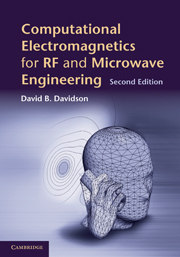Book contents
- Frontmatter
- Dedication
- Contents
- Preface to the second edition
- Preface to the first edition
- Acknowledgements
- To the reader
- List of notation
- 1 An overview of computational electromagnetics for RF and microwave applications
- 2 The finite difference time domain method: a one-dimensional introduction
- 3 The finite difference time domain method in two and three dimensions
- 4 A one-dimensional introduction to the method of moments: modelling thin wires and infinite cylinders
- 5 The application of the FEKO and NEC-2 codes to thin-wire antenna modelling
- 6 The method of moments for surface modelling
- 7 The method of moments and stratified media: theory
- 8 The method of moments and stratified media: practical applications of a commercial code
- 9 A one-dimensional introduction to the finite element method
- 10 The finite element method in two dimensions: scalar and vector elements
- 11 The finite element method in three dimensions
- 12 A selection of more advanced topics in full-wave computational electromagnetics
- Appendix A The Whitney element
- Appendix B The Newmark-β time-stepping algorithm References
- Appendix C On the convergence of the MoM Reference
- Appendix D Useful formulas for simplex coordinates
- Appendix E Web resources
- Appendix F MATLAB files supporting this text
- Index
- References
4 - A one-dimensional introduction to the method of moments: modelling thin wires and infinite cylinders
Published online by Cambridge University Press: 05 July 2014
- Frontmatter
- Dedication
- Contents
- Preface to the second edition
- Preface to the first edition
- Acknowledgements
- To the reader
- List of notation
- 1 An overview of computational electromagnetics for RF and microwave applications
- 2 The finite difference time domain method: a one-dimensional introduction
- 3 The finite difference time domain method in two and three dimensions
- 4 A one-dimensional introduction to the method of moments: modelling thin wires and infinite cylinders
- 5 The application of the FEKO and NEC-2 codes to thin-wire antenna modelling
- 6 The method of moments for surface modelling
- 7 The method of moments and stratified media: theory
- 8 The method of moments and stratified media: practical applications of a commercial code
- 9 A one-dimensional introduction to the finite element method
- 10 The finite element method in two dimensions: scalar and vector elements
- 11 The finite element method in three dimensions
- 12 A selection of more advanced topics in full-wave computational electromagnetics
- Appendix A The Whitney element
- Appendix B The Newmark-β time-stepping algorithm References
- Appendix C On the convergence of the MoM Reference
- Appendix D Useful formulas for simplex coordinates
- Appendix E Web resources
- Appendix F MATLAB files supporting this text
- Index
- References
Summary
Introduction
The method of moments – MoM – was one of the first numerical methods to achieve widespread acceptance in electronic engineering for the analysis of antennas and scatterers. It is generally defined as a method for reducing an integro-differential equation to a set of linear equations. The origins of the method are old: as was already indicated in Chapter 1, some of the early work was done over a century ago. One of the widely used integral equation formulations still used for the analysis of thin wires (that due to Pocklington) was first presented in 1897 (although he used a series expansion method, rather than the modern segmentation approach). The first publications in the antenna and propagation professional literature were in the early 1960s, and some of the canonical papers (those of Harrington, Richmond, Mei and Andreasen) appeared at much the same time as Yee's paper. The specific name “method of moments” was introduced by Harrington in his early work, and the name caught on quickly; this was perhaps unfortunate, since the name has a slightly different meaning in contemporary applied mathematics. In that field, and also fields such as computational mechanics, the term “method of weighted residuals” is generally used for what has become known as the MoM in radio-frequency engineering. Another term widely used in other fields of engineering is “boundary element method”; for highly conducting structures, this term and the MoM as used in electromagnetics are synonymous.
Information
- Type
- Chapter
- Information
- Computational Electromagnetics for RF and Microwave Engineering , pp. 130 - 165Publisher: Cambridge University PressPrint publication year: 2010
